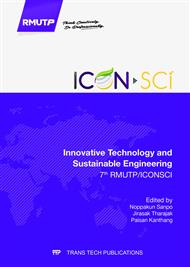p.3
p.8
p.12
p.17
p.21
p.25
p.29
p.33
Nanoemulsion Containing SangYod Rice Bran Oil and Thanakha Extracts: In Vitro Antioxidant and Irritation Assessments
Abstract:
Nanoemulsions are well characterized in a promising drug delivery system with applications for drug and cosmetic. Traditionally and cosmetic industries use Rice bran oil and Hesperethusa crenulata or Thanakha bark aqueous extract in sunscreen formulations, anti ageing products and in treatments for skin diseases. The aim of this study was to produce the nanoemulsion and to evaluate their physical stability, irritation potential. In vitro study, the total phenolic contents and total antioxidant capacity of SangYod Rice bran oil (SRBO) were 1130.44 ± 53.55 mg GAE/mg and 25.94±4.69 mmol TEAC/mg and Thanakha were 3.85±0.23 mg GAE/gdw and 19.87 ± 2.59 mmol TEAC/gdw, respectively. The nanoemulsion containing SRBO and Thanakha, oil in water, was produced using low-pressure homogenizer and ultrasonicator techniques and the particle size was 167.03±1.75 nm. The stability of nanoemulsion represented no significant change on pH and particle size after day 0, 5, 11, 14 and over 12 month at temperature 4, 25 and 40 °C. Moreover, it’s also showed no irritation on HET–CAM test, a basic test for embryotoxicity, systemic toxicity and immunopathology. Conclusion, these results suggested that the nanoemulsion containing SRBO and Thanakha may serve as potential vehicles for improved transdermal delivery antioxidant compound and no irritation.
Info:
Periodical:
Pages:
3-7
Citation:
Online since:
June 2017
Keywords:
Price:
Сopyright:
© 2017 Trans Tech Publications Ltd. All Rights Reserved
Share:
Citation:


